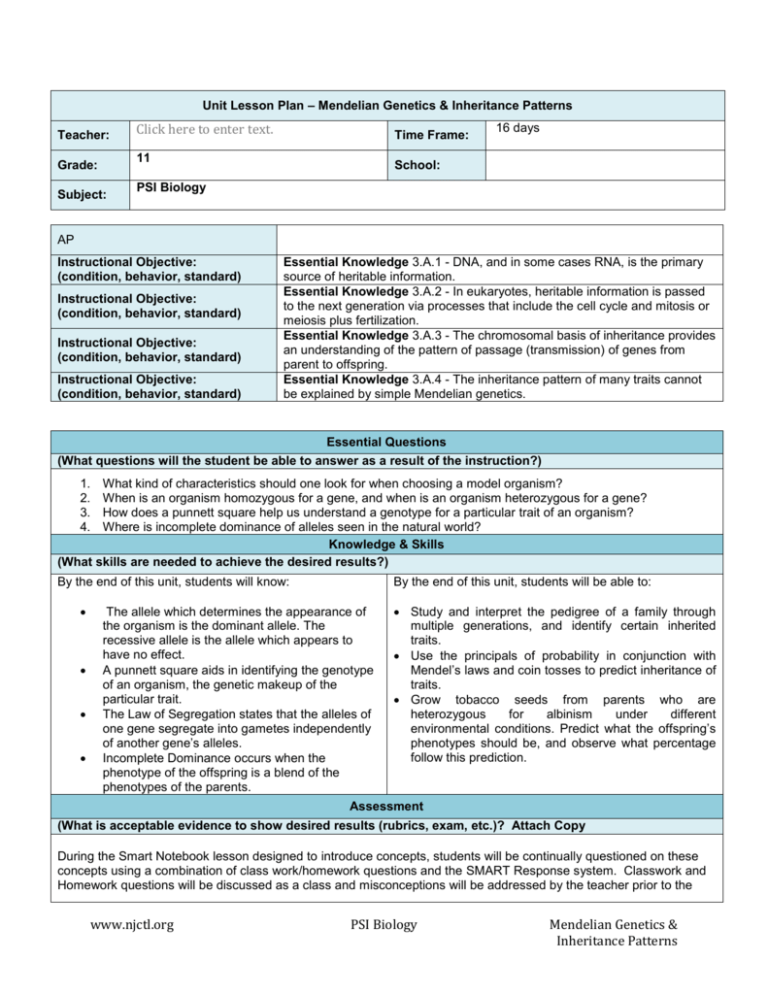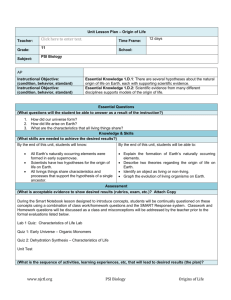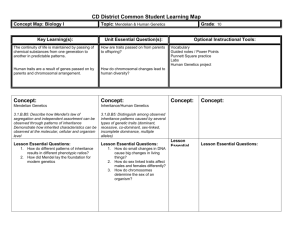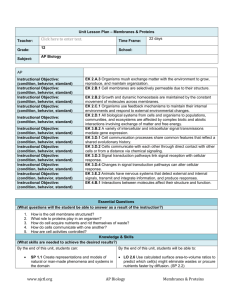Essential Questions
advertisement

Unit Lesson Plan – Mendelian Genetics & Inheritance Patterns Teacher: Click here to enter text. Time Frame: 11 Grade: Subject: 16 days School: PSI Biology AP Instructional Objective: (condition, behavior, standard) Instructional Objective: (condition, behavior, standard) Instructional Objective: (condition, behavior, standard) Instructional Objective: (condition, behavior, standard) Essential Knowledge 3.A.1 - DNA, and in some cases RNA, is the primary source of heritable information. Essential Knowledge 3.A.2 - In eukaryotes, heritable information is passed to the next generation via processes that include the cell cycle and mitosis or meiosis plus fertilization. Essential Knowledge 3.A.3 - The chromosomal basis of inheritance provides an understanding of the pattern of passage (transmission) of genes from parent to offspring. Essential Knowledge 3.A.4 - The inheritance pattern of many traits cannot be explained by simple Mendelian genetics. Essential Questions (What questions will the student be able to answer as a result of the instruction?) 1. 2. 3. 4. What kind of characteristics should one look for when choosing a model organism? When is an organism homozygous for a gene, and when is an organism heterozygous for a gene? How does a punnett square help us understand a genotype for a particular trait of an organism? Where is incomplete dominance of alleles seen in the natural world? Knowledge & Skills (What skills are needed to achieve the desired results?) By the end of this unit, students will know: By the end of this unit, students will be able to: The allele which determines the appearance of the organism is the dominant allele. The recessive allele is the allele which appears to have no effect. A punnett square aids in identifying the genotype of an organism, the genetic makeup of the particular trait. The Law of Segregation states that the alleles of one gene segregate into gametes independently of another gene’s alleles. Incomplete Dominance occurs when the phenotype of the offspring is a blend of the phenotypes of the parents. Study and interpret the pedigree of a family through multiple generations, and identify certain inherited traits. Use the principals of probability in conjunction with Mendel’s laws and coin tosses to predict inheritance of traits. Grow tobacco seeds from parents who are heterozygous for albinism under different environmental conditions. Predict what the offspring’s phenotypes should be, and observe what percentage follow this prediction. Assessment (What is acceptable evidence to show desired results (rubrics, exam, etc.)? Attach Copy During the Smart Notebook lesson designed to introduce concepts, students will be continually questioned on these concepts using a combination of class work/homework questions and the SMART Response system. Classwork and Homework questions will be discussed as a class and misconceptions will be addressed by the teacher prior to the www.njctl.org PSI Biology Mendelian Genetics & Inheritance Patterns formal evaluations listed below. Lab 1: Blood Typing Laboratory Quiz 1: Mendel & Monohybrids Quiz 2: Dihybrids & Probability Quiz 3: Non-Mendelian Genetics, Disorders & Pedigrees Unit Test (What is the sequence of activities, learning experiences, etc, that will lead to desired results (the plan)? Topic Classwork Homework 1 Mendel SMART Notebook Slides 520; Questions #1-9 #18-22 2 Hybridization SMART Notebook Slides 21-36; Questions #10-17 #23-30 3 Punnett Squares – Monohybrid SMART Notebook Slides 37-61; Questions 31-40 #49-54 4 Probability Probability Activity Analysis 5 Punnett Squares – Dihybrid Quiz 1 SMART Notebook Slides 62-66; Questions 41-43 #55-57 6 Probability SMART Notebook Slides 67-78; Questions #44-48 #58-60 7 Non-Mendelian Genetics – Codominance & Incomplete Dominance Quiz 2 SMART Notebook Slides 79-86; Questions #61-65 #71-74 8 Blood Typing Lab Blood Typing Lab Analysis 9 Non-Mendelian Genetics – Pleitropy & Polygenic Lab Quiz SMART Notebook Slides 87-100; Questions 66-70 #75-80 Day www.njctl.org PSI Biology Mendelian Genetics & Inheritance Patterns 10 Genetic Disorders SMART Notebook Slides 101-126; Questions 81-89 #92-99 11 Genetic Screening SMART Notebook Slides 127-136; Questions 90-91 #100-102 12 Pedigrees SMART Notebook Slides 137-170; Questions 103108 #109-114 13 Pedigrees Pedigrees Activity Analysis 14 Review Quiz 3 MC/FR MC/FR 15 Review Vocabulary Concept Mapping MC/FR MC/FR Pre Assessment Evol: Vocabulary Concept Mapping *Lessons are based on 40minute periods and may need to be adjusted to fit the schedule of your school. 16 www.njctl.org Test Unit Test PSI Biology Mendelian Genetics & Inheritance Patterns









